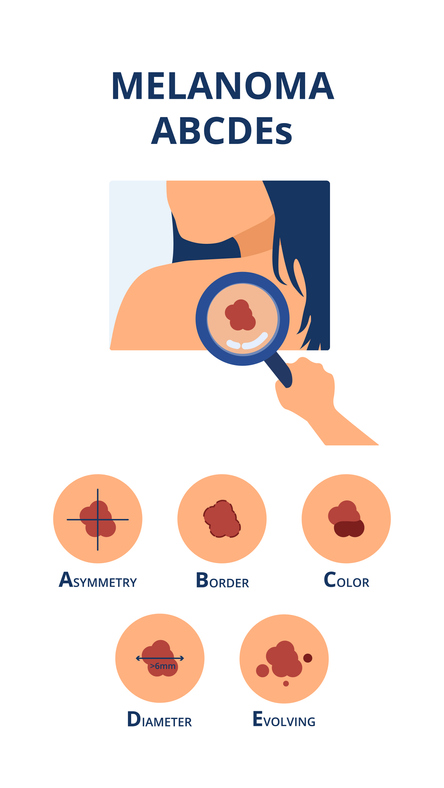The truth behind three common, deadly skin cancer myths
3 Deadly Myths About Skin Cancer Debunked
Think skin cancer isn’t serious? Think again.
In the United States, 1 in 5 Americans will develop skin cancer before 70, and two people die from skin cancer every hour. When detected early, skin cancers like melanoma have a 5-year survival rate of approximately 99%.
Not only is skin cancer deadly and common, but several myths about this type of cancer also prevent people from seeking treatment and practicing prevention. Since skin cancer can present in many forms, you might wonder what the most dangerous type of skin cancer is, and how to keep yourself safe. Once you learn more about skin cancer facts, you’ll be able to focus on early detection and prevention. Read on to learn the truth behind three common, deadly skin cancer myths.
Myth One:
Skin Cancer Is Not a Serious Disease
Some make the incorrect assumption that it’s less risky because the cancer is on the surface of your skin, instead of on an internal organ.In fact, more people get skin cancer diagnoses than all the other types combined, each year. The statistics are just as alarming for nonmelanoma skin cancers.
- About 5,400 people die each month across the globe from nonmelanoma skin cancer.
- It’s estimated that as many as 90% of nonmelanoma skin cancers come from exposure to the sun’s ultraviolet (UV) radiation.
- There are about 3.6 million diagnoses of basal cell carcinoma (BCC) each year. In the US, about 1.8 million cases of squamous cell carcinoma (SCC) are diagnosed yearly.
- While the survival rate five years out might be promising for early-detected melanoma, that changes with some other factors. For example, when melanoma reaches the lymph nodes, the survival rate drops to 71%.
- If the cancer reaches other body organs and metastasizes, the survival rate plummets to 32%.

What Is the Most Dangerous Type of Skin Cancer?
One of the most dangerous and serious types of skin cancer is melanoma. Melanoma develops in cells called melanocytes, which produce the melanin in our skin. Melanin is what gives your skin color, or even the appearance of a tan.
Melanoma often develops from a mole and can present on nearly any body part. It’s most common for melanoma to appear in areas where there’s sun exposure. You might be surprised to learn that as few as five sunburns can as much as double your risk for developing melanoma.
With some simple care and regular monitoring of your skin, you can catch a potential melanoma early. Early warning signs include:
- An existing mole that presents with some changes in shape or color
- New growth on the skin
- Change in pigment color on the skin
Doctors use an ABCDE model to help in the identification of melanomas. It includes:
- A: a mole presenting with an asymmetrical shape
- B: borders that present with irregular, notched, or scalloped appearances
- C: color that changes, or is uneven
- D: diameter growth that is new or changing in shape
- E: an evolving mole that changes over time
You can learn more about the signs of melanoma and other skin cancers here.
Myth Two:
Only Fair-Skinned People Get Skin Cancer
Can skin cancer kill you if you have dark skin? Can skin cancer kill you if you have light skin? The truth is that the sun’s UV radiation is colorblind, and anyone exposed to it can be impacted.
Some studies indeed suggest that people with lighter skin are more susceptible to melanoma. Those with darker skin naturally have more pigment in their skin, which acts as a mild sun protection factor (SPF).
However, this does not suggest that those with darker skin are safe from it. One study suggested that people who tan, or have naturally darker skin, often get a melanoma diagnosis at a later stage of cancer.
It’s worth noting that those with darker skin and more pigment are likely to present with skin cancer in places like the palms of their hands, under their fingernails, or on the soles of their feet.
What’s Your Skin Type?
Fitzpatrick skin typing is a classification of skin types related to sunburn risks and skin cancers. Skin types range from very light (type 1) to very dark (type 6). Type 1 skin is very pale, with green or blue eyes and red or light hair. Features of the other types include:
- Type 2 skin is pale with blue eyes and doesn’t tan easily
- Type 3 skin is fair with brown eyes and hair and burns first
- Type 4 skin is light brown with dark eyes and hair and burns a little
- Type 5 skin is brown skin with dark eyes and hair that easily tans
- Type 6 skin is dark brown or black with dark eyes and hair and never burns
Remember, these skin types are just a guide. Your exact skin type may not fit into a specific category.
Myth Three:
Sunscreen Is Only Needed When It’s Sunny
The truth is that the sun’s UV rays can damage your skin at any time of the year, even when it’s cloudy. In fact, 80% of the sun’s UV rays pass through clouds.
UVA rays can affect the skin through clouds, glass, and even smog. They cause premature aging, like wrinkles. UVB rays cause your skin to tan and burn, and cause immediate damage to the skin. This also means that, even during winter, UV rays reflect off the snow and damage your skin, while, in the summer, the sun reflects off the water and sand.
One of the most effective methods for cancer prevention – aside from limiting your UV exposure – is to use sunscreen. Those who regularly use sunscreen with an SPF of 15 or higher on a daily basis can reduce the chances of developing melanoma by as much as 50%.
The importance of starting early with sunscreen on children can’t be overstated. For example, just one bad sunburn in childhood or adolescence can double the chances of melanoma developing later in life.
It’s essential to understand sunscreen for it to be most effective. You want a broad-spectrum SPF 30 or higher for any time spent outdoors. It should be reapplied every two hours to all exposed skin.
It’s also worth noting that staying covered while out in the sun is the best prevention.
Help Prevent Skin Cancer By Remembering These Common Myths
Understanding the truth about skin cancer and the statistics can be a big motivator in protecting your skin.
If you’re facing a cancer diagnosis, we want to help. Speak with our experts to learn more about our treatment plans, and let’s discuss your case.
Additional Resources:
- Skin cancer: Facts and stats Dartmouth Geisel School of Medicine
- Skin cancer facts & statistics Skin Cancer Foundation
- Nonmelanoma Skin Cancers: Lesser Known, More Common Kelsey-Seybold Clinic
- Melanoma:Statistics American Society of Clinical Oncology
- All About Sunscreen Skin Cancer Foundation
- Why Do You Need Sunscreen on a Cloudy Day Health Central
- The science of sunscreen Harvard Health
- Clearing Up Myths About Skin Cancer in People of Color Michigan Medicine – University of Michigan
- Which Fitzpatrick skin type are you Medical News Today





Comments